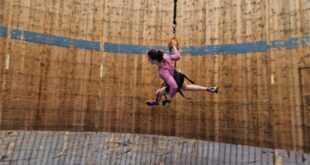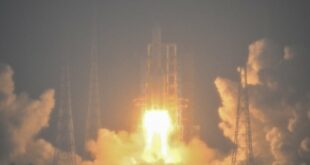Ignace area, South Bruce in southwestern Ontario potential sites to store Canada's nuclear waste

After travelling across the Atlantic Ocean and taking an elevator hundreds of metres underground, it's hard for Jodie Defeo to put into words what it was like to be among a handful of people in Finland to take in the world's first long-term geological repository for spent nuclear fuel.
"It was large. It was very cavernous. There was room for large-scale trucks to manoeuvre in these tunnels," Defeo, one of four councillors in the small northwestern Ontario township of Ignace, said about the facility.
Defeo was among a 10-member Ignace delegation who were in the municipality of Eurajoki, on the west coast of Finland, earlier this month to visit the Onkalo deep geological repository, which is under construction and expected to be completed within a year.
The northwestern Ontario group was sent on the all-expenses-paid trip by the Nuclear Waste Management Organization (NWMO), the non-profit tasked with choosing the location for a similar deep geological storage site for Canada's nuclear waste.
Late next year, NWMO will choose between:
- The Wabigoon Lake Ojibway Nation-Ignace area, about 250 kilometres northwest of Thunder Bay.
- The Saugeen Ojibway Nation-South Bruce area in southern Ontario, about 130 kilometres northwest of London.
This summer, South Bruce representatives also visited the Finnish site, with costs also covered by the NWMO.
For years, both communities targeted to possibly house the Canadian nuclear waste storage site have been dealing with arguments for and against being chosen as host.
Canadian storage site expected to be $26B project
For Defeo, the trip was unlike anything she had ever experienced.
"I was very excited and I think some of that was contagious because our host of course demonstrated a lot of pride in being the first [country] in the world … to come up with a solution for spent nuclear energy," she said.
Vince Ponka, NWMO's regional communications manager for northern Ontario, has referred to Canada's first nuclear waste repository as a $26-billion project, and says it is expected to create between 400 and 600 jobs. If built in Ignace, he said, the township's population of roughly 1,000 could double.
While the project has already been under much scrutiny, particularly from groups such as Nuclear Free Thunder Bay and Environment North, it's a long time coming. Construction is anticipated to begin in 2033, with the site operational by the early 2040s.
Photos were not permitted underground at Onkalo for security reasons, Ignace's communications contact, Jake Pastore, told CBC News.
Community willingness
Besides touring the repository itself, the visitors from Ignace also saw the community's nuclear education centre, which Defeo said is similar to the Ignace Learn More Centre, and a nuclear power plant.
She also met residents in the community and got to have more off-the-cuff conversations about the project.
"They expressed that they felt safe living in communities that hosted [a repository] very close to them, that they had no concerns, that they were kept informed with all of the parts of the process," Defeo said.

That transparency is something researcher Gareth Law said has played a big role in the Onkalo project.
Law, a radiochemistry professor at the University of Helsinki, has spent his career studying nuclear waste and its disposal. There are a number of nuclear power plants near Onkalo — Law said that has influenced the community's willingness to host the repository.
"People have been living next to these nuclear reactors now for several decades and there has never been any major incidents at the site," said Law.
"Many people living in the area are also working [at] these reactor sites, so they already have nuclear [power] in their backyards — so there's none of this sort of NIMBYism, not in my backyard, attitudes in this area of Finland."
In contrast, there are no nuclear power plants near Ignace, which means if the community is chosen to host a repository, spent nuclear fuel must be transported hundreds of kilometres from southern Ontario.
"The issue of not having something in your area and then accepting it, well, that's one I feel of public communication of risk and then also public communication of the benefits that might come from hosting one of these facilities — jobs, infrastructure, etcetera," Law said.
Push for proximity principle
Last month, about 50 people protested outside Thunder Bay city hall to push council to vote in favour of something called the proximity principle, which calls for nuclear waste to be stored in newly reinforced storage bins at the site of a nuclear reactor rather than being transported elsewhere.
Council voted to defer the decision until after its intergovernmental affairs committee did more consultations with Nuclear Free Thunder Bay and Environment North.
Fort William First Nation member Celina McCoy Reitberger said she is disheartened by the city's lack of consultation with her community. Her band council passed a resolution last September that called for the Ontario government to adopt the proximity principle.

"What does that say about reconciliation if City Hall does not consult, does not consider the position of the Fort William First Nation?" McCoy Reitberger asked during last month's rally.
The band council resolution, which was obtained by CBC News, cites safety concerns with transporting nuclear waste across Highways 102 and 17.
Ponka of NWMO maintains "the safety standards around nuclear are so strong that shipping of our material is extremely safe and has an unblemished track record."
Law's research has also shown a solid track record for safely transporting nuclear waste, both in Finland and worldwide, he said.
Layers of protection
There have been decades of research around what would be the safest way to store nuclear waste. As Law explained, there are multiple layers of protection to prevent it from being exposed to the outer environment.
The spent fuel is put in a cast iron insert that is placed inside a large canister made of copper alloy, which is corrosion resistant and prevents water from getting inside. The canister is then sealed and surrounded with bentonite clay buried at least 500 metres beneath the ground. The final, and biggest, barrier is the rock formation itself.
"The engineered barriers and the natural barriers should stop the radionuclides getting to the surface for many hundreds of thousands of years into the future," said Law.

As Defeo explored the Onkalo repository, she said, she found it clean, safe and dry — not cold and wet as one might imagine. According to Ponka, it's expected to be operational within a year.
Law said public communication has been a top priority in Finland, and he hopes the Ignace delegation takes that into consideration in sharing their experiences with the community.
"One thing that has been learned globally from radioactive waste disposal is that if you don't take a community with you, then ultimately that project will fail into the future," he said.
As it waits to learn which Ontario community will be chosen for the repository, Ignace is moving ahead with a willingness engagement study to assess the public's perceptions.
Town staff have selected a specialized community engagement team through With Chéla Inc. to conduct surveys over the next several months.
"Regardless of where this goes, it's pretty exciting to be part of that conversation for Canada," said Defeo.
"Being part of a very few people that will touch a piece of the earth that you know has never been touched — those are some pretty humbling experiences."
*****
Credit belongs to : www.cbc.ca
 MaharlikaNews | Canada Leading Online Filipino Newspaper Portal The No. 1 most engaged information website for Filipino – Canadian in Canada. MaharlikaNews.com received almost a quarter a million visitors in 2020.
MaharlikaNews | Canada Leading Online Filipino Newspaper Portal The No. 1 most engaged information website for Filipino – Canadian in Canada. MaharlikaNews.com received almost a quarter a million visitors in 2020.







